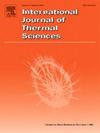Experimental investigation of film hole layout on turbine endwall along conjugate temperature gradient
IF 4.9
2区 工程技术
Q1 ENGINEERING, MECHANICAL
International Journal of Thermal Sciences
Pub Date : 2025-03-07
DOI:10.1016/j.ijthermalsci.2025.109841
引用次数: 0
Abstract
A layout of film holes on the endwall, based on conjugate temperature gradient lines, is proposed. Wind tunnel tests were conducted to measure the overall cooling effectiveness of the endwall surface with different film hole layouts. The effects of mass flow ratio, temperature ratio, and turbine expansion ratio were analyzed. And the dynamic cooling performance of film holes arranged along the temperature gradient was obtained. The layout of film holes along the temperature gradient removes obstructions to the cooling airflow. Case3 demonstrated superior cooling ability than other layouts, attributed to both a tighter connection of cooling jets and a more uniform distribution of overall cooling effectiveness across the affected area. An increase in mass flow rate enhances the local blowing ratio, improving cooling capability within a certain range. However, when the blowing ratio exceeds a specific threshold, it leads to flow separation between the film holes, which adversely affects cooling performance. As the temperature ratio increases, the overall cooling effectiveness decreases in regions both far from and affected by the influence of film cooling, but the latter experiences a smaller relative reduction. Additionally, an increase in the expansion ratio reduces the area of high cooling effectiveness near the hole outlets and diminishes overall cooling effectiveness downstream of these outlets. Furthermore, a greater expansion ratio correlates with a more pronounced decline in overall cooling effectiveness.
求助全文
约1分钟内获得全文
求助全文
来源期刊

International Journal of Thermal Sciences
工程技术-工程:机械
CiteScore
8.10
自引率
11.10%
发文量
531
审稿时长
55 days
期刊介绍:
The International Journal of Thermal Sciences is a journal devoted to the publication of fundamental studies on the physics of transfer processes in general, with an emphasis on thermal aspects and also applied research on various processes, energy systems and the environment. Articles are published in English and French, and are subject to peer review.
The fundamental subjects considered within the scope of the journal are:
* Heat and relevant mass transfer at all scales (nano, micro and macro) and in all types of material (heterogeneous, composites, biological,...) and fluid flow
* Forced, natural or mixed convection in reactive or non-reactive media
* Single or multi–phase fluid flow with or without phase change
* Near–and far–field radiative heat transfer
* Combined modes of heat transfer in complex systems (for example, plasmas, biological, geological,...)
* Multiscale modelling
The applied research topics include:
* Heat exchangers, heat pipes, cooling processes
* Transport phenomena taking place in industrial processes (chemical, food and agricultural, metallurgical, space and aeronautical, automobile industries)
* Nano–and micro–technology for energy, space, biosystems and devices
* Heat transport analysis in advanced systems
* Impact of energy–related processes on environment, and emerging energy systems
The study of thermophysical properties of materials and fluids, thermal measurement techniques, inverse methods, and the developments of experimental methods are within the scope of the International Journal of Thermal Sciences which also covers the modelling, and numerical methods applied to thermal transfer.
 求助内容:
求助内容: 应助结果提醒方式:
应助结果提醒方式:


